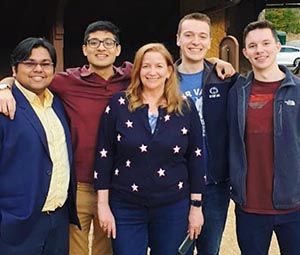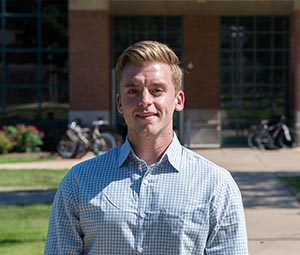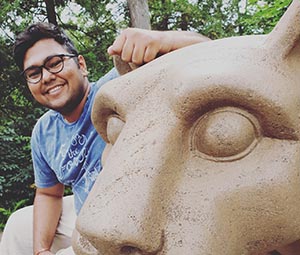Industrial engineering students find 'presidential' success
6/16/2020
By Miranda Buckheit
UNIVERSITY PARK, Pa. — Penn State industrial engineers are known for their ability to tackle topics such as sustainability, innovation and best practices with a goal of creating systems that help businesses and other organizations run seamlessly. With these specific skills, another necessary trait becomes apparent: leadership.
Three undergraduate students from the Harold and Inge Marcus Department of Industrial and Manufacturing Engineering — Benjamin Hartleb, a recently graduated industrial engineering student; Neel Mehta, a third-year industrial engineering student; and Dhir Agrawal, a second-year industrial engineering student — took their respective engineering skills and broadened their knowledge with the Presidential Leadership Academy (PLA).
The PLA is run by Penn State President Eric J. Barron; Peggy A. Johnson, dean of the Schreyer Honors College; and Melissa Doberstein, PLA director. The mission of the PLA is to prepare students to make decisions in a “gray world.” Selected students learn how to navigate issues of life at work, at home and in their communities.
At the end of a student’s first year, they are able to apply for the PLA via a very selective process. Only 30 of the most impressive students are selected each year based on their applications, essays, recommendations and in-person interviews.
Over the course of three years with the PLA, students take classes with Barron and Johnson that focus on making heavy decisions. Prior semesters focused on University budgets, free speech and sustainability in the State College community. In addition, they meet special speakers, go on field trips, network and receive mentoring.
“Ben, Neel and Dhir are fabulous to work with,” Doberstein said. “They are all super smart, very ambitious and so personable. I always found them intuitive and eager to learn. That is why PLA is open to all majors across campus: we want to hear from students across disciplines.”
Hartleb knew that he wanted to get involved with the PLA when he discovered it his first year at the University Park campus. He explained that he always found importance in “surrounding yourself with people smarter than you” in order to progress and develop as a young professional.
For Mehta, it was a conversation with Barron that opened his eyes to the opportunity.
“I came up to visit University Park when I was a senior in high school because my brother is an alumnus, and I happened to meet Dr. Barron,” Mehta said. “He invited me into his office and while we were talking about Penn State, he told me about PLA. He explained that he goes to his PLA students to hear their perspectives on decisions because he enjoys interacting with them. I knew I had to apply.”
Agrawal noted that the access to highly ranked University officials was a draw of the PLA. He explained that the PLA has given him more confidence, and he feels “less overwhelmed being around high-ranking officials in the Penn State community and beyond.”
For all three, the PLA offered an interesting array of networking field trips to notable cities such as Baltimore; Philadelphia; Washington, D.C.; Nashville; Chicago; and Los Angeles.
“It’s important that we get the students out in front of notable members of society; this past semester the students got to meet the mayor of Nashville,” Doberstein said. “The PLA offers a platform for the students to network in and out of class.”
It’s not all fun and games; being a member of the PLA has a host of responsibilities for the students, such as their classes with Barron and Johnson, their bimonthly blog posts and their class projects.
Doberstein explained that the class projects serve as a way for students to learn more about other majors by communicating and working together to solve tough problems. She explained that her best engineering students in the program are those that “can communicate clearly and work with those outside of their discipline.”
For Hartleb, his project on sustainability encapsulated how to make livable spaces with retail capabilities in the downtown State College area. Hartleb said that the experience opened up his perspectives on the power of effective housing policies.
While not all projects see action, the work teaches the students valuable lessons in analytical and communications skills.
“I think the biggest thing that I learned in PLA during my project was the ability to just sit back and listen,” Hartleb said. “It’s important to read the room and be willing to change your perspective.”
As future industrial engineers, all three of the students explained that their future roles rely heavily on the ability to effectively communicate with key stakeholders. They all feel that the PLA helped sharpen their business and communications skills, which in turn will make them more successful in their career endeavors.
Agrawal just wrapped up his first year of the PLA. He feels that the experience has been incredibly influential in his life and future goals, and he holds it in high regard.
“You can’t doubt yourself,” Agrawal said. “The PLA is all about people and what you bring to the table. Everything that you learn from being in the PLA has correlation to real life. You can see why people make their decisions.”






